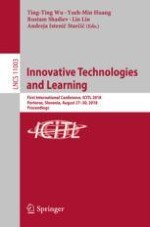This book constitutes the refereed proceedings of the First International Conference on Innovative Technologies and Learning, ICITL 2018, held in Portoroz, Slovenia, in August 2018.
The 66 revised full papers presented together with 4 short papers were carefully reviewed and selected from 160 submissions. The papers are organized in the following topical sections: Augmented and Virtual Reality in Education; Collaborative Learning; Design and Framework of Learning Systems; Instructional Strategies; Learning Analytics and Education Data Mining; Mind, Brain and Education; Pedagogies to Innovative Technologies; Personalized and Adaptive Learning; Social Media and Online Learning; Technologies Enhanced Language Learning; Application and Design of Innovative Learning Software; Educational Data Analytics Techniques and Adaptive Learning Applications; and Innovative Thinking Education and Future Trend Development.
